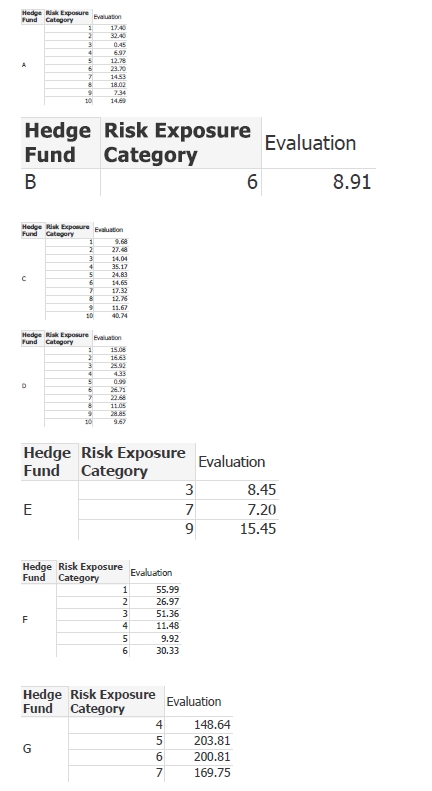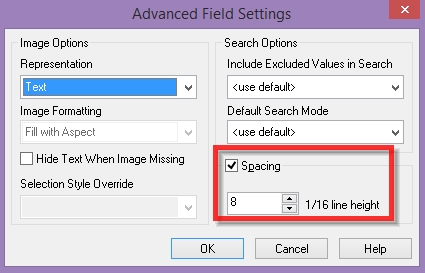Unlock a world of possibilities! Login now and discover the exclusive benefits awaiting you.
- Qlik Community
- :
- All Forums
- :
- QlikView App Dev
- :
- Re: Re: Overstretched grid for Report
- Subscribe to RSS Feed
- Mark Topic as New
- Mark Topic as Read
- Float this Topic for Current User
- Bookmark
- Subscribe
- Mute
- Printer Friendly Page
- Mark as New
- Bookmark
- Subscribe
- Mute
- Subscribe to RSS Feed
- Permalink
- Report Inappropriate Content
Overstretched grid for Report
Dear Gurus,
I have created QV report. When we create report, we have 3 options: Clip, Fill, Fill with Aspects.

We have 'volatile' table, which has sometimes many rows otherwise a few (or even no rows).
- If we select Clip, then the data is cut if many rows existed;
- if we select Fill or Fill with Aspect, the contents are overstretched if rows are few.
[Example of too few rows]

[Example of many rows]

At the current best capability of QlikView, what would you do for such cases without changing the grid logic?
- Mark as New
- Bookmark
- Subscribe
- Mute
- Subscribe to RSS Feed
- Permalink
- Report Inappropriate Content
I would use a multi-page format, and use the 'fill' option. This way, if there are more rows than fit on the page, they would just go to another page rather than affecting the layout.
- Mark as New
- Bookmark
- Subscribe
- Mute
- Subscribe to RSS Feed
- Permalink
- Report Inappropriate Content
Dear Charlotte, I appreciate for feedback. In my case, I had to put 7 such grid (as a summary briefing of results of the year). Some grid is none, some grid is too many. So size does not match in each grid. The suggested countermeasure is good for single grid/table, but if I had to place multiple grids, it fails the reporting standard.
So far, we thought fixing row titles (dimention) so that fixed number of rows are feasible. Currently row title is dynamic.
I'd appreciate for any thoguhts.
- Mark as New
- Bookmark
- Subscribe
- Mute
- Subscribe to RSS Feed
- Permalink
- Report Inappropriate Content
It would help if you attached a sample or provide a mock-up of what you're trying to achieve, as there are many scenarios and requirement possibilities that we are likely to misunderstand your desired result.
Let's not forget that the Reports in QlikView only offers basic capabilities, with no real dynamic object placements, etc... so be prepared to compromise a little in the output.
If you have multiple objects (table or charts) that you're trying to fit onto the one page, I would try to fix the size of these objects. Go to Properties -> Layout -> Uncheck "Size to Data". This way, it doesn't matter if you have zero rows or too many rows, the size of the object won't change. In the case where you have too many records, it's possible that you won't be able to see every row/column due to the limited size of the object. I would suggest you separate the information shown in the object (e.g. table), from one table into 2 tables (again with a fixed size).
I would avoid using the "Fill" option in the Report, as this doesn't play well with small or fixed-size objects (i.e. text becomes too big or too small, etc...).
Again, without really understand what you're trying to achieve, this is only to give you some ideas on what you can possibly try.
S.
- Mark as New
- Bookmark
- Subscribe
- Mute
- Subscribe to RSS Feed
- Permalink
- Report Inappropriate Content
Dear Shawn, I appreciate for your contribution. I will supply the report sample, which describes current issue.
As you see here, the report has 7 grids, however, due to the 'risk exposure' column varies depending on the fund, resulted report becomes like this. Since A4 1page should contain the 7 grids, I am unable to use Clip option.

[The option NOT considered hereby]
As you mention, we could use dedicated reporting tool such as ChrystalReport, Jusper, .... Change of the grid is also not the option.
[Background/Context]
FOF (Fund of funds) requires certain comparison in fund groups (particularly hedge fund) to compare certain KPIs/risk exposure in portfolio. The evaluation is internally calculated. We have:
- Fund group selected by user (A, B, C...). How many funds to be included are constantly changing, as this application is used for light-simulation purpose.
- Fixed income product is the element in its investment portfolio: (it is rather a risk category of various indicators) categorized and shown as 1, 2, ....... This is dynamic value;
These groups are dynamically calculated rather frequently, so group A might have only 5 risk categories then next week could have 8 (depending on information available at the hour/day/week).
- Mark as New
- Bookmark
- Subscribe
- Mute
- Subscribe to RSS Feed
- Permalink
- Report Inappropriate Content
Base on your example, it looks like your report is quite linear. Personally, I would not split the hedge fund into individual tables. Instead, I would have just one table, like you have done with the "Master" table.
Anyhow, I've created 2 sample reports in the QVW, and also attached their output for you to have a look, as I'm not sure how flexible you are with producing a single-page or multi-page reports. Basically, the single page report is quite straight forward. I then increased the font size on the other table in order to force it to go onto multiple pages to demonstrate how it would look in the report when your data starts to grow.
Keep in mind that you can only fit so much information into a single page before you hit that limit, and have to compromise on font size or "look and feel" of the report.
Cheers,
S.
- Mark as New
- Bookmark
- Subscribe
- Mute
- Subscribe to RSS Feed
- Permalink
- Report Inappropriate Content
Dear Shawn, I appreciate for your fast reply. Besides it is a novel idea to use the spacing in the label.

However; enduser's requirement was to split the tables (and put basic chart + text comments on the right side of each chart per fund group). I perhaps conclude that:
•since number of rows are dynamic, we would not be able to meet requirement to have dynamic but well-formatted report (like HTML page).
•choosing fill, single grid page with breaks between categories would fit in single page, given that there is some data in it.
I conclude the topic and I appreciate for highly interesting presentation in Dimension.